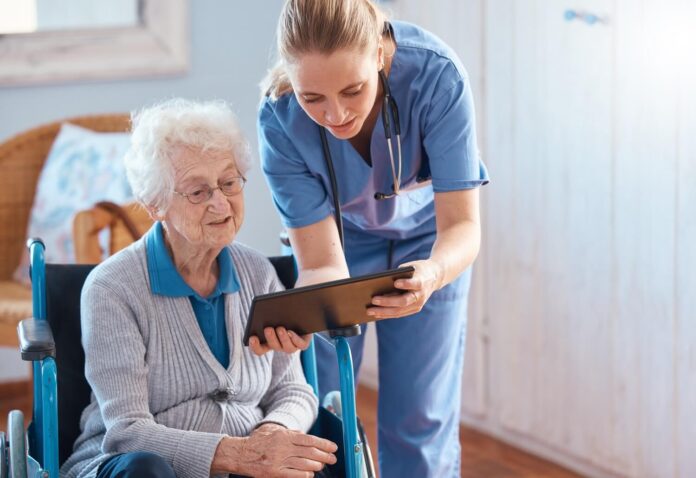Senior care business is facing a monumental shift. As demand for services rises, fueled by aging populations and evolving expectations, businesses must adapt or risk being left behind. But how can organizations navigate this transformation effectively? The answer lies in embracing technology as a strategic ally.
The Role of Technology in Modernizing Senior Care
Innovation is reshaping how senior care is delivered, managed, and experienced. For providers, adopting assisted living solutions isn’t just about keeping up with trends—it’s about redefining care to meet the needs of both today’s residents and tomorrow’s families. Integrating technology allows businesses to enhance operational efficiency, elevate the quality of care, and provide more personalized experiences.
For example, electronic health records (EHR) simplify resident data management in nursing homes, enabling caregivers to spend less time on paperwork and more on meaningful interactions with senior citizens. Similarly, predictive analytics tools help identify health risks before they escalate, empowering teams to act proactively rather than reactively. In this way, technology transforms care from being just responsive to genuinely anticipatory.
Why Future-Proofing Matters
The senior care industry operates in an environment of constant change. Regulatory requirements evolve, labor shortages persist, and families demand greater transparency. Without the agility to adapt, businesses risk becoming irrelevant.
Technology serves as a bridge, offering solutions to some of the industry’s most pressing challenges in settings like retirement communities:
- Staffing shortages: Automated systems streamline tasks, reducing the burden on overworked teams while ensuring consistent service quality.
- Resident expectations: Today’s seniors are more tech-savvy than previous generations. Smart home features, virtual communication tools, and engaging digital platforms aren’t just optional perks; they’re becoming essential.
- Regulatory compliance: Software platforms help businesses stay ahead of ever-changing rules, minimizing the risk of costly fines and reputational damage.
Future-proofing isn’t about predicting every twist and turn. It’s about building resilience through tools that allow organizations to pivot when needed. Fostering this adaptability enables senior care businesses to thrive amid uncertainty.
How to Leverage Technology Effectively
Adopting technology is more than a one-time investment; it’s a strategic process. To maximize benefits, senior care providers should:
- Evaluate Needs Thoroughly: Before implementing solutions, identify key pain points. Are caregivers overwhelmed by manual tasks? Are families asking for better communication channels? Pinpointing priorities allows you to select tools that address the most pressing challenges.
- Invest in Training: Even the best technology fails without proper training. Equip staff with the skills to use new systems confidently, ensuring seamless integration into daily workflows.
- Prioritize Scalability: Technology should grow with your organization. Choose platforms that can accommodate increased residents, expanded services, or additional locations without significant overhauls.
- Focus on Resident Experience: At its core, senior care is about people. Use technology to enhance their lives—whether through telemedicine for easier healthcare access or personalized apps that keep families connected.
Approaching technology adoption as a continuous journey rather than a destination enables senior care providers to unlock long-term value. Every step forward—no matter how small—builds a foundation for innovation that benefits residents, staff, and families alike.
The Emotional Impact of Technology in Senior Care
Technology’s impact goes beyond operations; it enhances relationships, fosters trust, and supports caregivers in delivering quality care that truly makes a difference. Imagine a caregiver who can spend more quality time with residents because administrative burdens are reduced. Picture families feeling reassured as they receive real-time updates about their loved ones. These moments create trust and connection—the cornerstone of successful senior care.
Moreover, technology fosters dignity for seniors in settings such as home care. Features like voice-activated assistants and health-monitoring wearables enable independence, allowing individuals to feel in control of their lives. When seniors experience autonomy, their quality of life improves, creating a ripple effect on their well-being and the satisfaction of those who care for them.

Challenges and Solutions
While the benefits of technology are immense, implementation isn’t without obstacles. Budget constraints, resistance to change, and cybersecurity concerns often hinder adoption. However, these challenges are manageable:
- Budget: Start small by prioritizing high-impact solutions and expanding incrementally. Demonstrate ROI through pilot programs to gain stakeholder support.
- Change Management: Involve staff early in the decision-making process to build buy-in. Highlight how technology simplifies their roles rather than replacing them.
- Cybersecurity: Partner with vendors who prioritize data protection and provide robust training on privacy best practices.
Overcoming these hurdles requires commitment and a clear vision, but the payoff is a stronger, more adaptable organization.
Looking Ahead
Technology isn’t a passing trend in the senior care business—it’s the foundation for a more sustainable future. Adopting the right tools and fostering a culture of innovation enables senior care businesses to not only weather the challenges ahead but also emerge stronger and more connected to the people they serve.
The question isn’t whether technology belongs in senior care. The question is how far you’re willing to go to create a future where residents, families, and caregivers feel supported and empowered.
